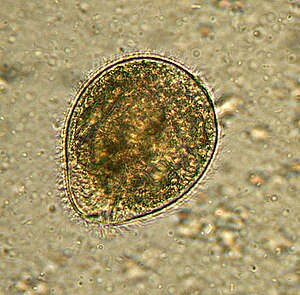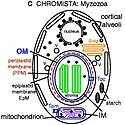Alveolata
| Alveolata | ||||||||||
|---|---|---|---|---|---|---|---|---|---|---|
 | ||||||||||
| Systematik | ||||||||||
| ||||||||||
| Wissenschaftlicher Name | ||||||||||
| Alveolata | ||||||||||
| Cavalier-Smith, 1991 |
Die Alveolata bilden ein Taxon einzelliger Eukaryoten. Zu ihnen gehören unter anderem die Dinoflagellaten (Dinoflagellata), die Apicomplexa und die Wimpertierchen (Ciliophora). Alle drei Stämme enthalten komplexe einzellige Lebewesen.
Merkmale
Namengebendes Merkmal sind bei den einzelnen Untertaxa unterschiedlich ausgestaltete flache Vakuolen unter der Zellmembran (Pellicula), sogenannte Alveolen, die bei einigen Arten wieder verloren gegangen sind. Die Funktion dieser Alveoli ist nicht in jedem Fall bekannt. Bei Dinoflagellaten sind diese Vakuolen bei vielen Arten mit Zellulose gefüllt und werden als Theka[1] bezeichnet.[2]
Weitere Merkmale sind röhrenförmige oder sich flaschenähnlich verjüngende Cristae in den Mitochondrien.[2]
Vermutlich ging die Gruppe vor 1,2 Milliarden Jahren aus einem Perkinsus-ähnlichen Vertreter hervor.[2]
Systematik

Thomas Cavalier-Smith.

Adl et al. (2012) unterteilen die Alveolata in folgende Gruppen:[3]
- Dinoflagellaten (Dinoflagellata)
- Apicomplexa
- Wimpertierchen (Ciliophora)
- Protalveolata
- Perkinsidae (mit Perkinsus und Parvilucifera)
- Chromerida
- Colpodellida (mit Colpodella)
- Syndiniales
- Oxyrrhis
- incertae sedis innerhalb der Alveolata:
- Colponema
- Ellobiopsidae
Das Taxon Protalveolata ersetzt das frühere Taxon Myzozoa Cavalier-Smith & Chao 2004 ab, das Dinoflagellaten, Apicomplexa, Chromerida und Perkinsozoa umfasste.
Nachweise
- ↑ F. J. R. Taylor: The Biology of dinoflagellates. Blackwell, 1987, ISBN 0-632-00915-2, doi:10.2307/1485469. Dazu:
- ↑ a b c Klaus Hausmann, Norbert Hülsmann, Renate Radek: Protistology, 3. Aufl., Schweizerbart, 2003, S. 81, ISBN 3-510-65208-8.
- ↑ Sina M. Adl, Alastair G. B. Simpson, Christopher E. Lane, Julius Lukeš, David Bass, Samuel S. Bowser, Matthew W. Brown, Fabien Burki, Micah Dunthorn, Vladimir Hampl, Aaron Heiss, Mona Hoppenrath, Enrique Lara, Line le Gall, Denis H. Lynn, Hilary McManus, Edward A. D. Mitchell, Sharon E. Mozley-Stanridge, Laura W. Parfrey, Jan Pawlowski, Sonja Rueckert, Laura Shadwick, Conrad L. Schoch, Alexey Smirnov, Frederick W. Spiegel: The Revised Classification of Eukaryotes. Journal of Eukaryotic Microbiology, Band 59, Nr. 5, S. 429–514, 28. September 2012; doi:10.1111/j.1550-7408.2012.00644.x, PDF.
Weblinks
Auf dieser Seite verwendete Medien
Autor/Urheber: Euthman, Lizenz: CC BY-SA 2.5
Balantidium coli in wet mount
Autor/Urheber: M. Alan Kazlev, Renato Filipe Vidal Santos, Roger Perkins; Chris Clowes, Christopher Taylor, Jcwf, Mikko Haaramo, Toby White, Lizenz: CC0
Essential structures (morphotype) of Colpodella, Perkinsus, and Parvilucifera (possibly basal alveolates). Complex anterior microtubular array from which the flagella emerge. Instead of only a posterior flagellar/feeding groove, we see both posterior and lateral grooves. At least one flagellum bears mastigonemes. The internal, alveolar membrane system is present, with micropores associated with the alveoli. Extrusomes (another apparent synapomorphy of Metabiotiformes) are present and take the form of elongate, somewhat club-shaped sacs terminating anteriorly. These are quite similar to the rhoptries of the Apicomplexa. Similarly, all genera have some sort of anterior conoid-like structure associated with predation or intracellular insertion in the Apicomplexa. Figure from Siddall et al. (2001).
Autor/Urheber: Thomas Cavalier-Smith (caption slightly moved, digitylly enhanced), Lizenz: CC BY-SA 4.0
Membrane structre of an algal chromista cell (myzozoa). These originated by secondary intracellular enslavement of a red algal plant cell. Both target nuclear-coded proteins to plastids by transit peptides (TPs) recognised by outer membrane (OM, blue) Toc receptors and to mitochondria (enslaved α-proteobacteria) by topogenic sequences recognised by OM Tom receptors. For clarity, peroxisomes and lysosomes omitted.
Myzozoa lack periplastid ribosomes, phycobilins, and nucleomorph DNA; thylakoids are stacked in threes; PPM (present in Apicomplexa—red dashed line; lost in Dinozoa) and plastids are not within the rough ER. The original phagosome membrane (now epiplastid membrane, EpM) remains smooth and receives vesicles (V) containing nucleus-encoded plastid proteins from the Golgi. Dinozoa lack PR, but Apicomplexa have a likely homologue (not shown).


